The result that the processed raw data produces, after being entered into a computer by an input device, is displayed by the output devices. Numerous output devices display output in different ways such as images, text, audio, video or hard copies.
Some of the most popular output devices are discussed below:
- Monitor
- CRT Monitor
- LCD Monitor
- LED Monitor
- Plasma Monitor
- Printer
- Impact printers
- Character Printers
- Dot Matrix Printers
- Daisy Wheel Printers
- Line printers
- Drum printers
- Chain printers
- Non-Impact printers
- Laser printers
- Inkjet printers
- Projector
1) Monitor
It is the screen or display unit of the computer. Monitor is the main output device that displays the processed information or data as images, text, video or audio.
Some common types of computers are discussed below
i) CRT Monitor
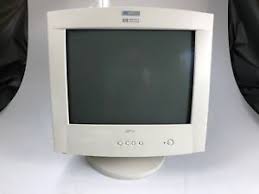
They are based on cathode ray tubes. They are identical to vacuum tubes and images are produced by them in the form of video signals. Cathode ray tubes use electron guns to produce a beam of electrons that produces electrons by striking on the inner phosphorescent surface of the screen. The monitor has millions of phosphorus dots of green, blue, and red colour. When electron beams strike these dots, they start to glow, this process is called cathodoluminescence.
Deflection plate assembly, electron gun assembly, glass envelop, base, and fluorescent screen are the main components of a CRT monitor. The front or the outer surface of the screen upon which the images are produced is known as the face plate. The face plate is made of fiber optics.
Three electron beams, blue, red and green, are there that strike the screen. Hence, the colours seen on the screen are the blends of green, blue and red lights. The electron beams are guided by magnetic fields. Even though CRT monitors have been replaced by LCDs, many graphic professionals still use them for their colour quality.
ii) LCD Monitor
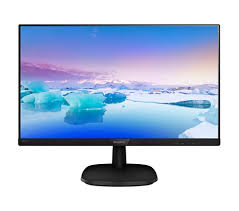
The LCD monitor is a compact, flat panel screen which is lighter in weight as compared to CRT monitors. The liquid crystal display technology which is used in tablets, smart phones, laptops, etc. is also used in LCD monitors. There are two layers of polarized glass present in an LCD screen, in between the two layers lies a liquid crystal solution. The liquid crystals are aligned with an electric current when the light passes through the first layer. For creating images on the screen, the liquid crystals so aligned allow a varying level of light to pass through the second layer.
The LCD screen contains a matrix of pixels that helps the image get displayed on the screen. Passive-matrix scenes are present in old LCDs under which a charge is sent to control individual pixels. There are high chances of a few electrical charges being sent which may lead to the screen appearing blurred in case the images moved quickly on the screen.
Modern LCDs contain Thin Film Transistors (TFTs) with capacitors and use active-matrix technology. With the help of this technology, pixels retain their charge. Hence, the screen doesn’t get blurred when quick movement of images happen on the screen. The efficiency of this technology is more than the passive-matrix displays.
iii) LED Monitor
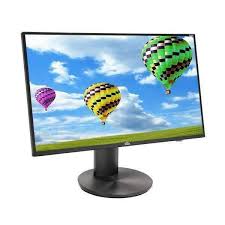
It is an improved version of the LCD monitor. Like the LCD monitor, it also uses liquid crystal display technology and has a flat panel display. However, what differentiates them is the source of light to backlight the display. The LED monitor contains various LED panels each of which consists of several LEDs to backlight the display unlike LCD monitors under which cold cathode fluorescent light is used. Modern electronic devices such as LED TVs, mobile phones, computer screen, laptops, etc. use an LED driven display because it not only produces greater light intensity and more brilliance but also consumes less amount of power.
iv) Plasma Monitor
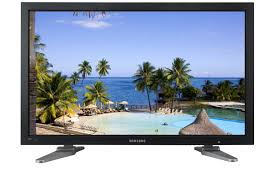
The plasma monitor uses plasma display technology and flaunts a flat panel display. Between two glass panels, It contains small tiny cells. The cells comprise of a small amount of mercury and mixtures of noble gases. When the infusion of voltage takes place, the gas present in the cells gets converted into plasma and emits ultraviolet light which in turn creates images on the screen. In other words, a tiny bit of plasma, that is a charged gas, illuminates the screen. Plasma displays are brighter and better than liquid crystal displays (LCD) and as compared to the latter, plasma displays offer a wider viewing angle.
Plasma monitors provide excellent contrast ratios, high resolutions of up to 1920 x 1080, a high refresh rate, wide viewing angle, etc. Therefore, with a plasma display you will experience a unique viewing experience while watching sports games, action movies, etc.
2) Printer
Hard copies of processed data are produced by a printer. It enables the user to print text, images or any other information upon a paper.
Printers are of two types: Impact and Non-Impact.
- Impact printers:
- Character printers
- Dot Matrix Printers
- Daisy Wheel printers
- Line printers
- Drum printers
- Chain printers
- Non-Impact printers:
- Laser printers
- Inkjet printers
Impact printer
A print head or a hammer is used by an impact printer for printing the images or characters on the paper. The print head or hammer presses or strikes an ink ribbon against the paper to print images and characters.
A) Character Printers
They print with a single stroke of the hammer or the print head or it can also be said that they print only a single character at a given time. It cannot print one full line at any given time. Daisy wheel printer and Dot Matrix printer fall in the category of character printers. Since they can only print text and that too with a slow speed, character printers are not in much use these days. The two types of character printers have been discussed below:
i) Dot Matrix Printer
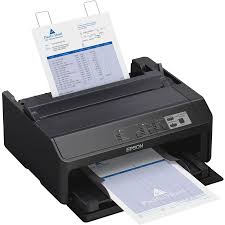
It is an impact printer that prints images and characters on the patterns of dots. To produce these dot patterns, a print head strikes the ink soaked ribbon against the paper. There are pins present in the print head that form individual characters by producing a pattern of dots on the paper. There are more number of pins present in the print head of a 24 pin dot matrix as compared to a 9 pin dot matrix printer due to which the former is able to produce more dots resulting in better printing of characters. A coloured output can be produced by changing the black ribbon with colour stripes. Dot matrix printers provide a speed of around 200-500 characters per second.
ii) Daisy Wheel Printer
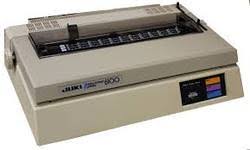
David S. Lee invented the daisy wheel printer at Diablo Data Systems. It is named Daisy Wheel Printer because it has a disk or a wheel that contains extensions or spokes and looks like a daisy. Moulded metal characters are mounted at the end of the extensions. To print a character, the wheel is rotated by the printer. When the concerned character reaches the print location the impression is created on paper after the hammer hits the disk and the extension hits the ink ribbon against the paper. These printers are slow and noisy. Their speed is around 25-50 characters per second and also they cannot print graphics. These drawbacks are the reasons behind these printers getting obsolete.
B) Line Printers:
Line printer is also a bar printer and prints one line at a time. It can print 500-3000 lines in one minute and hence it is a high-speed impact printer. Its examples include chain printer and drum printer.
i) Drum Printer:
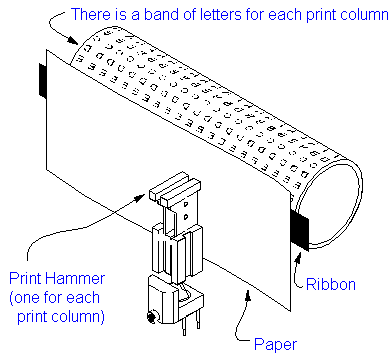
It is a line printer that uses a rotating drum to print characters. On its surface, the drum contains circular band of characters and for each band of characters the printer has a separate hammer. The drum rotates itself when a print command is given. The moment when the desired characters come under the hammer, the ink ribbon is struck by the hammer, against the paper, to print characters. The speed of the drum’s rotation is very high and appropriate hammers are used to print the characters. All the characters may not be printed at a time but the speed of printing remains very high. Since the printer contains a specific set of characters, it can only print a predefined style. The use of hammering techniques makes these printers very noisy.
ii) Chain Printer:
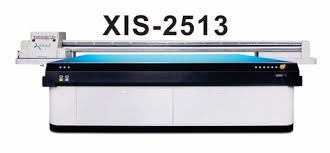
It is a line printer under which a rotting chain is used to print characters. On the surface of the chain, the characters get embossed. The rotation of chain takes place horizontally around a set of hammers; one hammer is provided for each print location which means that the number of total hammers equals the number of total print positions,
When the desired characters come at the print location, the chain rotates at a very high speed. The page is then struck by the corresponding hammer against the character and ribbon on the chain. They have a good speed and can type around 500-3000 lines in one minute. The hammering action makes them noisy as well.
Non-Impact Printer
These printers do not strike the ink ribbon, placed against the paper, by a hammer or print head for printing images or characters. They print images and characters without letting the paper and printing machinery come into direct physical contact. They have the capacity of printing a complete page at a given time and hence, they are also called as page printers. Laser printer and inkjet printer are the two most common types of Non-Impact printers.
i) Laser printer:
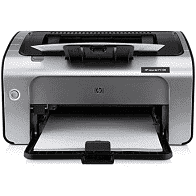
It is a non-impact printer under which a laser beam is used to print characters. There’s a photoreceptor drum present inside the printer. The drum is hit by the laser beam and the required image is drawn on the drum after altering the electrical charges on the drum. In the next step, the drum rolls in toner, and the toner is picked by the charged image present on the drum. Then heat and pressure is used to print the paper on the toner. At the end, the remaining toner is collected since there is no electric charge left in the drum after the document is printed. Instead of ink, powdered toner is used for printing by the laser printers and in this way quality print objects having a resolution of 600 dots per inch (dpi) or more are printed by them.
ii) Inkjet printer:
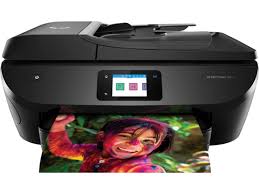
It sprays fine, ionized drops of ink for printing images and characters. To spray the ink, the print head contains tiny nozzles. Ionized drops of ink are sprayed on the paper when the printer head moves back and forth. The paper is fed through the printer. The ionized drops pass through an electric field that takes the ink onto the paper for printing correct characters and images.
The cartridges of inkjet printers contain ink. There are four different colours of cartridges present in modern printers that specialize in coloured printing: Magenta, Cyan, Black and Yellow. High quality images with different colours can be printed by these printers. Its printed objects carry a resolution of 300 dots per inch (dpi), at least.
3) Projector

This output device helps the user to display the desired output on a large surface such as a wall or big screen. To project the output on the screen, a projector can be connected to a computer, laptop or other similar devices. Light and lenses are used by it to produce magnified images, videos and texts. Hence, to teach large number of students or to give presentations, a projector is an ideal device.
There are multiple input sources present in modern projectors such as VGA ports that support older devices and HDMI ports that cater to new equipment. Some of the projectors also support WiFi and bluetooth. They can be easily placed on a stand, fixed on the ceiling and are used more frequently for giving presentations, classroom teaching, home cinemas, etc.
There are two types of digital projectors:
Liquid Crystal Display (LCD) digital projector: They are lightweight and provide crisp output and are hence highly popular. Transmissive technology is used by an LCD projector to produce the output. It allows the standard lamp, which is the light source, to pass through the liquid crystal light panels that contain three colours. The required colours are allowed to pass through the panels and the ones that are not required for the output are blocked.
Digital Light Processing (DLP) digital projector: There’s a set of tiny mirrors present in these projectors. For each pixel of the image, a separate mirror is there and as a result the output is of a higher and better quality. Since these projectors fulfil the need of high-quality video output, they are mostly used in theatres.